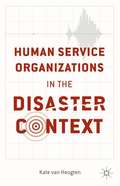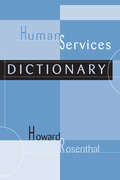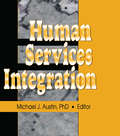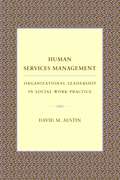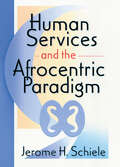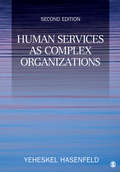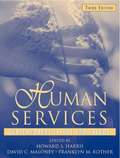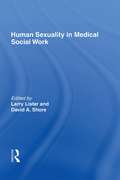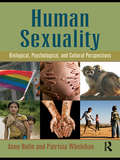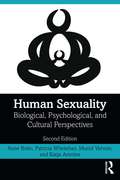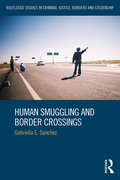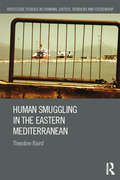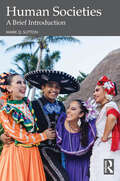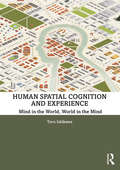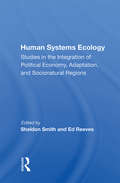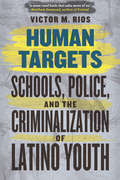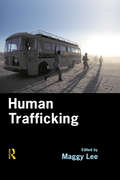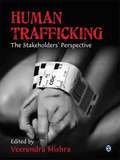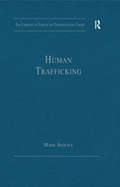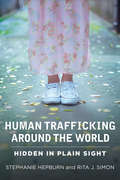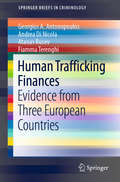- Table View
- List View
Human Service Organizations in the Disaster Context
by Kate Van HeugtenHuman Service Organizations in the Disaster Context explores the efforts of human service practitioners to support communities facing the impacts of large-scale hazardous events. Using the stories of frontline workers and managers who lived through devastating earthquakes in Canterbury, New Zealand in 2010 and 2011, and drawing on international research and sociological theory, van Heugten astutely analyses the challenges and opportunities that arise. In the immediate aftermath of disasters, there is often a surge in altruism giving rise to hope for improved social cohesion. This hope wanes when negative impacts fall unequally on people living in poverty and other vulnerable populations. Political, financial, and professional interest groups vie for power and local citizens' voices are frequently overruled. Human service workers act as boundary spanners, networking between organizations to draw attention to the concerns of vulnerable people, and to advocate for human rights and social justice.
Human Service Program Planning Through a Social Justice Lens
by Irwin NesoffHuman Service Program Planning Through a Social Justice Lens provides a foundation in social justice to students while developing practical skills and knowledge about the steps and tasks involved in planning social programs.Through the "parallel process" of contextualizing social issues while teaching the process of program planning, students will develop a perspective on the need for social justice planning and its impact on marginalized communities and populations. The textbook explores current concepts and approaches to understanding social issues and involving impacted communities and individuals. These include: Intersectionality, Appreciative Inquiry, Participatory Planning and Visioning, which serve to challenge preconceptions while coupling these with the step-by-step approach to planning using the Logic Model.Utilizing meaningful examples to demonstrate how social justice planning can be implemented, Human Service Program Planning Through a Social Justice Lens is appropriate for students of social work as well as practitioners in human services, public administration and public health.
Human Service Program Planning Through a Social Justice Lens
by Irwin NesoffHuman Service Program Planning Through a Social Justice Lens provides a foundation in social justice to students while developing practical skills and knowledge about the steps and tasks involved in planning social programs.Through the "parallel process" of contextualizing social issues while teaching the process of program planning, students will develop a perspective on the need for social justice planning and its impact on marginalized communities and populations. The textbook explores current concepts and approaches to understanding social issues and involving impacted communities and individuals. These include: Intersectionality, Appreciative Inquiry, Participatory Planning and Visioning, which serve to challenge preconceptions while coupling these with the step-by-step approach to planning using the Logic Model.Utilizing meaningful examples to demonstrate how social justice planning can be implemented, Human Service Program Planning Through a Social Justice Lens is appropriate for students of social work as well as practitioners in human services, public administration and public health.
Human Services Dictionary
by Howard RosenthalWritten in an interesting, accessible and informative manner, with 1600 entries this book is an ideal reference for human service professionals and students preparing for exams. Special features include: extensive cross-referencing, a directory of human service organizations, short biographies of important figures in the profession, a short history of human services, and specialized and slang terms specific to the human service profession.
Human Services Integration
by Michael J AustinAddressing the multiple meanings of service integration, Human Services Integration analyzes how motivations and expectations for social service integration differ significantly among different players in the service system. In a period of major budget cutbacks and welfare reform, however, it is important that service providers collaborate to reduce or eliminate boundaries between categorically defined and provided services. This book tells you about the efforts being made to provide existing services more efficiently while avoiding duplication and waste. As you will quickly see, developing consensus for service integration efforts at the administrative, community, and staff levels will result in the ability to set achievable goals and objectives and secure cooperation at all levels.Human Services Integration covers practice principles for managing organizational and community change and offers strategies for organizing human service agencies and overcoming fragmented service integration in communities with complex problems and needs. To also help you identify specific service intergration activities that are relevant in the context of unique communities, it discusses: specifications for conducting a self-assessment of progress at the local level toward social service integration goals Georgia&’s Family Connection, a statewide human services initiative interweaving formal and informal systems of care in a community-centered approach to service integration a children’s initiative collaborative social science theory pertinent to service integration gathering support from elected officials such as boards of supervisors, city leaders, and local elected boardsHuman Services Integration will help you understand why service integration cannot be defined by a particular service model or outcome. Its insight will also help you understand why involving service users and community members in the design and delivery of services is fundamental to developing an integrated service system that is culturally competent, empowering, and responsive to its neighborhood and community context.
Human Services Management: Organizational Leadership in Social Work Practice (Foundations of Social Work Knowledge Series)
by David AustinHuman services management occurs in nonprofit, governmental, and for-profit sectors and involves a wide variety of organizational structures. These diverse conditions shape the effort to produce and project services that directly affect the quality of life of individuals, families, and communities through social welfare, health and mental health, criminal justice, and educational services. David Austin begins with an examination of the historical development and distinctive characteristics of human service organizations, the variety of organizational and program structures at play, and the connection of individual service organizations with service delivery networks. He then examines of the roles and responsibilities of key stakeholder constituencies, including service users, service personnel (especially service professionals), funders, executives, and policy boards. The final two chapters discuss two organizational processes: accountability for effectiveness and dealing with organizational changes.
Human Services and the Afrocentric Paradigm
by Jerome H SchieleDiscover how human services professionals can help to eliminate cultural oppression!Human Services and the Afrocentric Paradigm presents a new way of understanding human behavior, attacking social problems, and exploring social issues. This excellent guide shows that understanding the simultaneous forces of oppression and spiritual alienation in American society serves as a foundation for understanding the societal problems here. The first book to offer a comprehensive exposition of how the Afrocentric paradigm can be used by human service professionals and community advocates, Human Services and the Afrocentric Paradigm discusses why and how human service work is hampered by Eurocentric cultural values and will help you to offer fair and effective services to your clients. Human Services and the Afrocentric Paradigm provides you with a concrete discription of how the Afrocentric model can be applied in human services to help people of all races and ethnicities. You will expand and diversify your knowledge base in human services by understanding the cultural values, traditions, and experiences of people of African ancestry.Some of the issues and concepts in the Afrocentric paradigm that you will explore are: defining the Afrocentric worldview, complete with a discussion of its philosophical assumptions and its shortcomings understanding traditional helping assumptions and methods of West African societies and how these have influenced the helping strategies of African-Americans exploring the strengths and weaknesses of some early African-American human service scholars, with special concern placed on their rejection of traditional African methods in favor of Eurocentric ideas resolving youth violence and helping people with substance abuse problems examining Afrocentric assumptions about resource distribution, morality, and societal relationships identifying organizational and conceptual differences in Eurocentric and Afrocentric paradigms creating organizational empowerment and an enhanced work environment via the Afrocentric paradigmHuman Services and the Afrocentric Paradigm will help you understand, solve, and prevent problems that are confronted by several races, especially individuals of African descent. This timely and relevant worldview is thoroughly explained to assist you in better serving people of color. The Afrocentric paradigm will help human services practitioners, administrators, policy advocates, analysts, educators, and black studies professors and students achieve educational and treatment objectives by showing you the importance of various cultural values and how to integrate them to make a difference!
Human Services as Complex Organizations
by Dr Yeheskel Hasenfeld"Hasenfeld has done it again. An excellent collection of essays on many of the most important trends and issues involving human service organizations."—Mayer N. Zald, Professor (emeritus), Sociology, Social Work, and Management, University of Michigan The Second Edition of this best-selling text provides a comprehensive and state-of-the-art perspective on human service organizations. This vanguard collection weaves the latest theoretical and empirical studies in macro theory with contemporary examples from hospitals, schools, social service organizations, mental health centers, and public welfare agencies. Blending theory with application, this outstanding anthology highlights the moral choices and accomplishments made by human service organizations. Key Features of This EditionPresents the latest theoretical and empirical studies on human service organizations, offering students key analytical tools to study and understand human behavior in various contexts. Introduces important new topics, such as the impact of the policy environment, emotional labor, and advocacy Offers students a new perspective with original studies on organizational ideologies, conditions of work, structuration of service technologies, diversity, and discretion. Intended Audience This exceptional compilation of the best theoretical and empirical studies on human service organizations is indispensable to graduate students and scholars of organization studies, organizational behavior, and Human Behavior in the Social Environment.
Human Services as Complex Organizations
by Dr Yeheskel Hasenfeld"Hasenfeld has done it again. An excellent collection of essays on many of the most important trends and issues involving human service organizations."—Mayer N. Zald, Professor (emeritus), Sociology, Social Work, and Management, University of Michigan The Second Edition of this best-selling text provides a comprehensive and state-of-the-art perspective on human service organizations. This vanguard collection weaves the latest theoretical and empirical studies in macro theory with contemporary examples from hospitals, schools, social service organizations, mental health centers, and public welfare agencies. Blending theory with application, this outstanding anthology highlights the moral choices and accomplishments made by human service organizations. Key Features of This EditionPresents the latest theoretical and empirical studies on human service organizations, offering students key analytical tools to study and understand human behavior in various contexts. Introduces important new topics, such as the impact of the policy environment, emotional labor, and advocacy Offers students a new perspective with original studies on organizational ideologies, conditions of work, structuration of service technologies, diversity, and discretion. Intended Audience This exceptional compilation of the best theoretical and empirical studies on human service organizations is indispensable to graduate students and scholars of organization studies, organizational behavior, and Human Behavior in the Social Environment.
Human Services in Contemporary America (Ninth Edition)
by William R. BurgerDesigned for introductory college courses in human services, mental-health technology, social work, community mental health, and other human services programs.
Human Services: Contemporary Issues and Trends (3rd edition)
by Howard S. Harris David C. Maloney Franklyn RotherThe third edition of this college textbook features articles on human services theory and application written by 40-plus well-known scholars in the field. The new edition includes new chapters and material on the importance of technology and social change, the effectiveness of the empowerment educational model, the historical roots of human services, techniques and skills for interviewing, the legal foundations of the field, emerging issues and trends affecting human service education and practice, service-learning, social norms theory, architectural design and corrections supervision, and short-term therapy. Annotation ©2004 Book News, Inc., Portland, OR (booknews.com)
Human Sexuality in Medical Social Work
by H Lawrence Lister David A ShoreParticularly valuable to social workers and health care personnel, this timely volume offers practical guidelines and unique treatment approaches to use with clients who have sex-related problems. Experts address sexual health and social work intervention in sexual problems. They also present important information on significant health problems--cancer, chronic illness; patient characteristics; and special issues, which illustrate the various social work intervention responses available to meet patients’sexual problems.
Human Sexuality: Biological, Psychological, and Cultural Perspectives
by Anne Bolin Patricia WhelehanHuman Sexuality: Biological, Psychological, and Cultural Perspectives is a unique textbook that provides a complete analysis of this crucial aspect of life around the world. Utilizing viewpoints across cultural and national boundaries, and deftly weaving evolutionary and psychological perspectives, Bolin and Whelehan go beyond the traditional evolution and primatology to address cross-cultural and contemporary issues, as well as anthropological contributions and psycho-social perspectives. Taking into account the evolution of human anatomy, sexual behavior, attitudes, and beliefs, this far-reaching text goes beyond what is found in traditional books to present a wide diversity of beliefs, attitudes, and behaviors found globally. In addition to providing a rich array of photographs, illustrations, tables, and a glossary of terms, this extraordinary textbook explores: pregnancy and childbirth as a bio-cultural experience life-course issues related to gender identity, sexual orientations, behaviors, and lifestyles socioeconomic, political, historical, and ecological influences on sexual behavior early childhood sexuality, puberty and adolescence birth control, fertility, conception, and sexual differentiation HIV infection, AIDS, AIDS globalization and sex work Fusing biological, socio-psychological, and cultural influences to offer new perspectives on understanding human sexuality, its development over millions of years of evolution, and how sexuality is embedded in specific socio-cultural contexts, this is the text for educators and students who wish to understand human sexuality in all of its richness and complexity.
Human Sexuality: Biological, Psychological, and Cultural Perspectives
by Anne Bolin Patricia Whelehan Muriel Vernon Katja AntoineThis groundbreaking second edition of Human Sexuality continues its broad and interdisciplinary goal of providing readers with a comprehensive overview on sexuality as a core part of our individual identities and social lives. Edited by anthropological experts on the subject, this unique textbook integrates evolutionary and cultural aspects to provide a fully interdisciplinary approach to human sexuality that is rare in this area of scholarship. Fully updated throughout in line with developments in the field, this second edition includes fresh material exploring new sexual identities, sexual violence and consent, Internet pornography, conversion therapy, polyamory, and much more. In addition to providing a rich array of photographs, illustrations, tables, and a glossary of terms, this textbook explores: pregnancy and childbirth as a bio-cultural experience life-course issues related to gender identity, sexual orientations, behaviors, and lifestyles socioeconomic, political, historical, and ecological influences on sexual behavior early childhood sexuality, puberty, and adolescence birth control, fertility, conception, and sexual differentiation HIV infection, AIDS, AIDS globalization, and sex work. Utilizing viewpoints across cultural and national boundaries and taking into account the evolution of human anatomy, sexual behavior, attitudes, and beliefs across the globe, Human Sexuality, Second Edition, remains an essential text for educators and students who wish to understand human sexuality in all of its richness and complexity.
Human Smuggling and Border Crossings (Routledge Studies in Criminal Justice, Borders and Citizenship)
by Gabriella SanchezGraphic narratives of tragedies involving the journeys of irregular migrants trying to reach destinations in the global north are common in the media and are blamed almost invariably on human smuggling facilitators, described as rapacious members of highly structured underground transnational criminal organizations, who take advantage of migrants and prey upon their vulnerability. This book contributes to the current scholarship on migration by providing a window into the lives and experiences of those behind the facilitation of irregular border crossing journeys. Based on fieldwork conducted among coyotes in Arizona - the main point of entry for irregular migrants in the United States by the turn of the 21st Century - this project goes beyond traditional narratives of victimization and financial exploitation and asks: who are the men and women behind the journeys of irregular migrants worldwide? How and why do they enter the human smuggling market? How are they organized? How do they understand their roles in transnational migration? How do they explain the violence and victimization so many migrants face while in transit? This book is suitable for students and academics involved in the study of migration, border enforcement and migrant and refugee criminalization.
Human Smuggling in the Eastern Mediterranean (Routledge Studies in Criminal Justice, Borders and Citizenship)
by Theodore BairdThe organization of human smuggling from the Middle East and Africa through Turkey and the Eastern Mediterranean has become a contemporary political concern throughout Europe, receiving intense and polarised media attention. This timely book reformulates how we conceive of human smuggling, challenging popular and political conceptions of the practice in Europe. This book proposes a new framework for examining the causes and effects of human smuggling in the Mediterranean, analysing the contingent patterns of human smuggling in the countries of the Eastern Mediterranean with a geographic focus on Turkey. Building on unique empirical material from fieldwork in Turkey and Greece, this book describes the rise of human smuggling as a practice, viewed through a framework of multiple 'contingencies'. Uniquely, this book includes in-depth testimonies of migrants who have survived crossing the Aegean Sea and details the strategies and tactics of the facilitators who help them. In Human Smuggling in the Eastern Mediterranean, Theodore Baird puts a human face to the tragedies occurring in the Mediterranean while maintaining that contingent historical, political, economic, and geographic forces have aligned to propel the practice of human smuggling forward. The book will be of interest to scholars working in migration studies, as well as scholars in the fields of sociology, criminology, law, political science, anthropology, and geography.
Human Societies: A Brief Introduction
by Mark Q. SuttonHuman Societies: A Brief Introduction succinctly covers the basic concepts of cultural anthropology in a way that is relevant and engaging to the introductory student. Less time is spent on anthropological detail and more time on the relevance of anthropological understanding to the contemporary world.The issues facing the contemporary Western world are also confronting the thousands of other societies. The book deals with topics such as the variety of sexualities, the thousands of religions, how people adapt to their environments, the ways people organize themselves, the multitude of foods and cuisines, adaptations to climate change, refugees and migrants, and the many different approaches to reproduction; all topics to which students should already be generally aware. Included are succinct chapters discussing personality; adaptation; social, political, and economic organization; food and diet; sex and gender; religion and ritual; and change and development. The book also includes short “Spotlight” boxes that enlighten the reader about specific topics of interest, as well as chapter summaries, exercises, key terms, and a comprehensive glossary.Human Societies: A Brief Introduction is essential reading for undergraduate students taking their first steps into cultural and applied anthropology.
Human Spatial Cognition and Experience: Mind in the World, World in the Mind
by Toru IshikawaThis book offers students an introduction to human spatial cognition and experience and is designed for graduate and advanced undergraduate students who are interested in the study of maps in the head and the psychology of space. We live in space and space surrounds us. We interact with space all the time, consciously or unconsciously, and make decisions and actions based on our perceptions of that space. Have you ever wondered how some people navigate perfectly using maps in their heads while other people get lost even with a physical map? What do you mean when you say you have a poor "sense of direction"? How do we know where we are? How do we use and represent information about space? This book clarifies that our knowledge and feelings emerge as a consequence of our interactions with the surrounding space, and show that the knowledge and feelings direct, guide, or limit our spatial behavior and experience. Space matters, or more specifically space we perceive matters. Research into spatial cognition and experience, asking fundamental questions about how and why space and spatiality matters to humans, has thus attracted attention. It is no coincidence that the 2014 Nobel Prize in Physiology or Medicine was awarded for research into a positioning system in the brain or "inner GPS" and that spatial information and technology are recognized as an important social infrastructure in recent years. This is the first book aimed at graduate and advanced undergraduate students pursuing this fascinating area of research. The content introduces the reader to the field of spatial cognition and experience with a series of chapters covering theoretical, empirical, and practical issues, including cognitive maps, spatial orientation, spatial ability and thinking, geospatial information, navigation assistance, and environmental aesthetics.
Human Systems Ecology: Studies In The Integration Of Political Economy, Adaptation, And Socionatural Regions
by Sheldon Smith Ed ReevesThis book presents nine case studies which illustrate an approach to the interface between human ecology, political economy, and adaptive decision making, demonstrating the power of analyzing socionatural regions from a human systems ecology perspective.
Human Targets: Schools, Police, and the Criminalization of Latino Youth
by Victor M. RiosAt fifteen, Victor Rios found himself a human target—flat on his ass amid a hail of shotgun fire, desperate for money and a place on the street. Faced with the choice of escalating a drug turf war or eking out a living elsewhere, he turned to a teacher, who mentored him and helped him find a job at an auto shop. That job would alter the course of his whole life—putting him on the road to college and eventually a PhD. Now, Rios is a rising star, hailed for his work studying the lives of African American and Latino youth. In Human Targets, Rios takes us to the streets of California, where we encounter young men who find themselves in much the same situation as fifteen-year-old Victor. We follow young gang members into schools, homes, community organizations, and detention facilities, watch them interact with police, grow up to become fathers, get jobs, get rap sheets—and in some cases get killed. What is it that sets apart young people like Rios who succeed and survive from the ones who don’t? Rios makes a powerful case that the traditional good kid/bad kid, street kid/decent kid dichotomy is much too simplistic, arguing instead that authorities and institutions help create these identities—and that they can play an instrumental role in providing young people with the resources for shifting between roles. In Rios’s account, to be a poor Latino youth is to be a human target—victimized and considered an enemy by others, viewed as a threat to law enforcement and schools, and burdened by stigma, disrepute, and punishment. That has to change. This is not another sensationalistic account of gang bangers. Instead, the book is a powerful look at how authority figures succeed—and fail—at seeing the multi-faceted identities of at-risk youths, youths who succeed—and fail—at demonstrating to the system that they are ready to change their lives. In our post-Ferguson era, Human Targets is essential reading.
Human Trafficking
by Maggy LeeHuman Trafficking provides a critical engagement with the key debates on human trade. It addresses the subject within the broader context of global crime and the internationalisation of crime control. The book takes a broadly discursive approach and draws on historical, comparative as well as the latest empirical material to illustrate and inform the discussion of the major trends in human trafficking. The book helps to develop fresh theoretical insights into globalisation, exclusion and governance, and identifies a new research agenda that will ensure the book is of interest to advanced level students as well as academic scholars.
Human Trafficking
by Veerendra MishraTrafficking of persons is a modern-day form of slavery, threatening the dignity and security of millions of people throughout the world. Virtually every country in the world and every state of India is affected by this crime as a place of origin, transit or destination for victims. This book is an attempt to discuss various issues of human trafficking, including perspectives of various stakeholders. The book argues that crime cannot be dealt with only by applying piecemeal tactics. Instead, it will require an organised professional, multi-disciplinary and multi-agency approach, calling for concerted, collaborative and participatory efforts of all stakeholders. All the essays included in this book are original works delving deeply into various forms of human trafficking. They are organised into different themes such as sexual exploitation, child trafficking, trafficking outside India, legal aspects, state experiences and case studies.
Human Trafficking (The Library of Essays on Transnational Crime)
by Marie SegraveHuman trafficking captured the attention of the global community well over a decade ago, inspiring multifarious international, national, regional and local responses. While formally recognized as one of the major threats associated with transnational organized crime, human trafficking remains an issue about which much has been written and yet little is known or supported by empirical evidence. The essays selected for this volume reflect four key areas of debate: the transnational organized crime framework; the data and research landscape; the implementation of anti-trafficking responses; and the articulation of alternative responses to human trafficking. These essays are written by well-known and more recent contributors to this field of research. The collection draws attention to contemporary arguments as well as recent empirical research, and points to the importance of contextualizing human trafficking within both the global and local setting. This volume reflects where human trafficking data, research and debate is currently located and where it is heading, and as such is of interest to academics, students, policymakers and practitioners.
Human Trafficking Around the World: Hidden in Plain Sight
by Rita Simon Stephanie HepburnThis unprecedented study of sex trafficking, forced labor, organ trafficking, and sex tourism across twenty-four nations highlights the experiences of the victims, perpetrators, and anti-traffickers involved in this brutal trade. Combining statistical data with intimate accounts and interviews, journalist Stephanie Hepburn and justice scholar Rita J. Simon create a dynamic volume sure to educate and spur action.Hepburn and Simon recount the lives of victims during and after their experience with trafficking, and they follow the activities of traffickers before capture and their outcomes after sentencing. Each chapter centers on the trafficking practices and anti-trafficking measures of a single country: Australia, Brazil, Canada, Chile, China, Colombia, France, Germany, India, Iran, Iraq, Israel, Italy, Japan, Mexico, Niger, Poland, Russia, South Africa, Syria, Thailand, the United Arab Emirates, the United Kingdom, and the United States. Examining these nations' laws, Hepburn and Simon reveal gaps in legislation and enforcement and outline the cultural norms and biases, societal assumptions, and conflicting policies that make trafficking scenarios so pervasive and resilient. This study points out those most vulnerable in each nation and the specific cultural, economic, environmental, and geopolitical factors that contribute to each nation's trafficking issues. Furthermore, the study also highlights common phenomena that governments and international anti-traffickers should consider in their fight against this illicit trade.
Human Trafficking Finances: Evidence from Three European Countries (SpringerBriefs in Criminology)
by Georgios A. Antonopoulos Andrea Di Nicola Atanas Rusev Fiamma TerenghiThis unique volume addresses the financial mechanisms that enable human trafficking - its actors, structures, and logistics. Viewing each stage of the market, human traffickers may need significant financial resources for recruitment, transportation, and exploitation. Drawing upon cross-disciplinary research expertise in criminology, sociology, law and economics, this book offers insights from law enforcement officers, policy makers, NGOs, and traffickers and their victims. Using three European countries - Bulgaria, Italy and the United Kingdom - it provides an account on the sources of capital for initiating and sustaining a human trafficking scheme, discussing the involvement of criminal structures, legitimate businesses, financial institutions, and information and communication technologies in the running of these enterprises. It also addresses the ways in which entrepreneurs and customers settle payments, the costs of conducting business in human trafficking, and how profits from the business are spent and invested.This important contribution to the transnational organized crime knowledge base will be of interest to researchers and academics, as well as law enforcement, regulatory agencies, and policy makers combating human trafficking.
